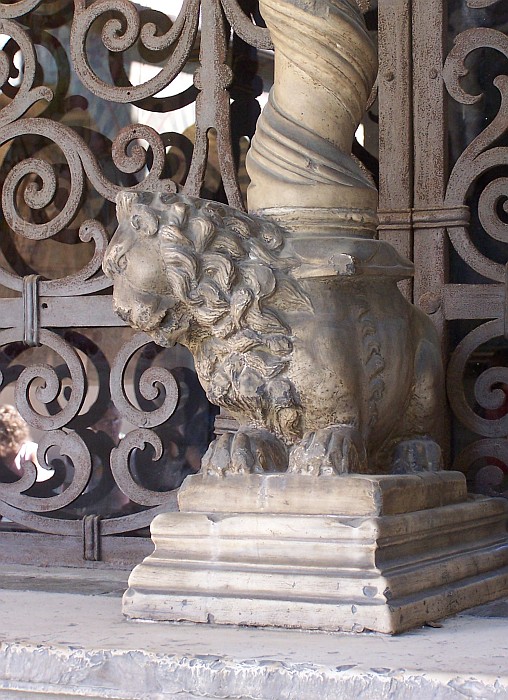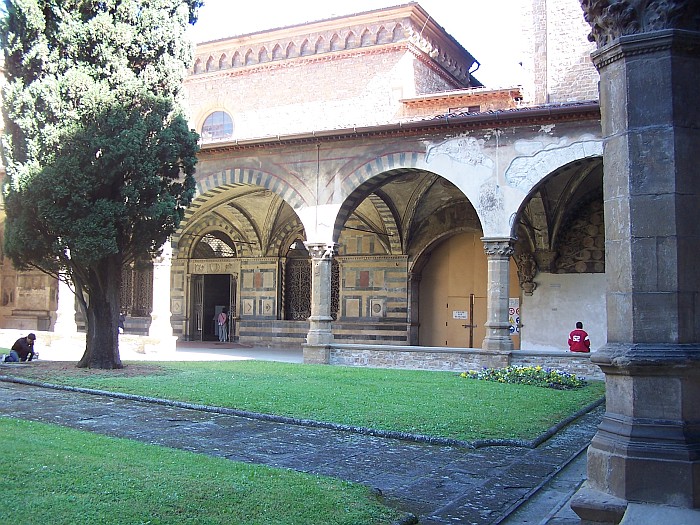

The Cloisters
The monumental complex of the cloister of Santa Maria Novella adjoins the church and is full of important art. Begun in 1340 and completed internally in 1360, the cloisters were designed by Fra' Sisto and Fra' Ristoro. They are among the most beautiful surviving examples of Italian Gothic architecture. Within the doorway to the right of the church facade is the “Chiostro Verde” with its strong but harmonious proportions. lt derived its name from the frescoes painted in "terra verde". Among the artists involved in the decorations during the first half of the fifteenth century, the most famous name is that of Paolo Uccello (1397-1494). One of the greatest Florentine Renaissance masters, Uccello painted some of his best works here, including the “Flood” and the “Sacrifice of Noah.”
Uccello, Creation of Adam and the Animals
Uccello, Creation and Temptation of Eve
Uccello, The Flood
Uccello, Sacrifice of Noah
· astonished his contemporaries with his skill in rendering
perspective
Spanish Chapel
Cappellone degli Spagnoli
The major difference between the two types of monasteries, Conventual and Observant, lay in questions of accessibility to non-members. It would have been practically impossible for women to enter either type of building but laymen would have found it much more difficult to enter a fully cloistered Observant house than its Conventual counterpart. Thus the Conventual Dominican monastery of Santa Maria Novella had a large apartment complex for important visiting guests. Popes Martin V and Eugenius IV ran the papal administration from these rooms and the retinues of other distinguished visitors were also housed here. The decoration of this space reflected its particular nature, with Donatello’s image of the Florentine lion, the Marzocco, serving as the newel-post for the staircase and papal heraldry painted in the rooms and corridors . . .

We can carry the comparison between these two monasteries further [San Marco and Santa Maria Novella]. Fresco-painting predominated on both sites, providing appropriate images for instruction, contemplation, and memorialization. The chapter house, for example, was the most public part of the cloister. Activities taking place here ranged from the most devout to the most mundane business affairs. But most importantly, this was the room where the friars gathered on a daily basis to confess their faults and receive admonitions and punishments. In Santa Maria Novella, the frescos painted by Andrea di Bonaiuti filled the entire wall and ceiling. On entering, the Dominicans or their visitors, who included men and women brought forward under accusations of heresy, were confronted with a detailed image of the Crucifixion. To their left was a vast and complex didactic scene of the Triumph of Saint Thomas Aquinas, a picture which required some knowledge of the encyclopaedic ideas of this great Dominican father of the Church. On the other side, they saw the promise of heavenly salvation which the Dominicans were able to provide to heretics through their teachings. When they raised their heads they were confronted with images of Christ’s calling to the Apostles and as they turned to leave, the brothers were reminded of what was expected of them through the images of the preaching of St Peter Martyr (c1205-52) who was murdered for his faith in the early thirteenth century.
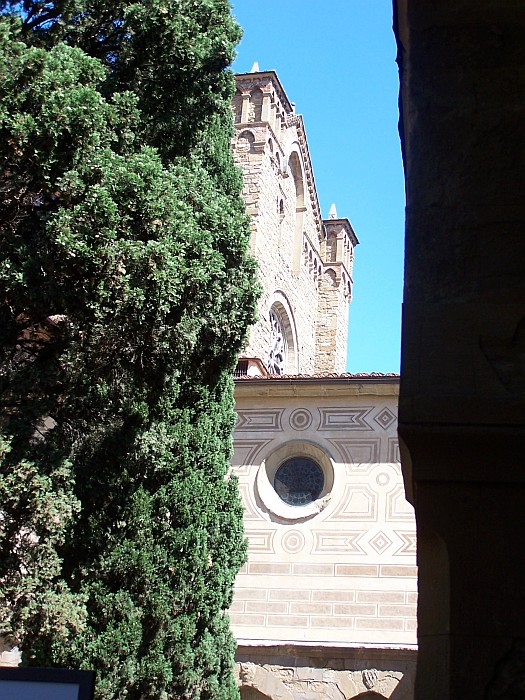
A complete understanding of the trecento frescos of Santa Maria Novella required considerable concentration; the frescos created almost a century later for the chapter house of San Marco were much more spare. Welch, Art and Society in Italy
· built and decorated with funds provided by Buonamico di
Lapi Guidalotti
· chamber behind altar used as a family burial chapel
· Andrea da Firenze (Andrea Bonaiuti) commissioned to paint
murals
· Altarpiece by Bernardo Daddi (1344) moved here from another
chapel inside church – Corpus Christi theme
· burial chamber behind altar transformed for use of Spanish
colony by Eleonora of Toledo – Grand Duchess of Tuscany – wife of Grand
Duke Cosimo I
· pictorial scheme based on Dominican concern with cult of
Eucharist or Corpus Domini
· Crucifixion directly above altar as well as over entrance
to former Corpus Domini Chapel
· On either side below are the Way to Calvary and Descent
into Limbo
· on entrance wall are scenes from life of St Peter Martyr
who died writing the words of the Creed in his own blood
· vault continues Christological cycle” Resurrection, Navicella,
Ascension and Pentecost
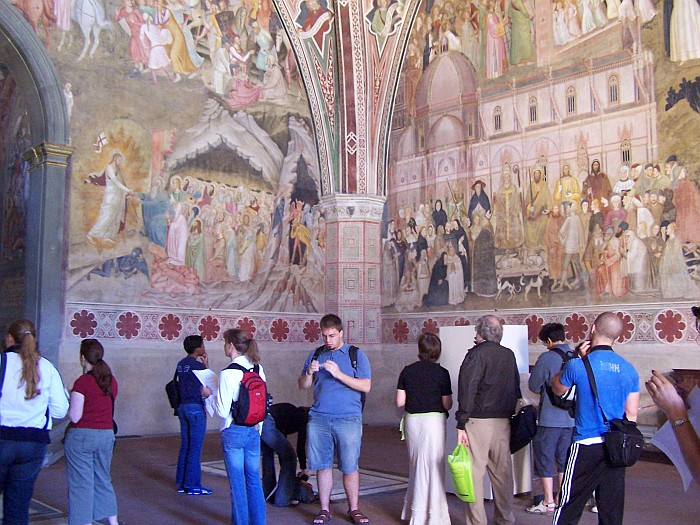
Wall Opposite the Entrance
Instead of painting the scenes in many panels, as the Giottesque artists did, Andrea di Buonaiuto carried out the narration of the Passion in a continuous fashion, with the scenes following along as in a film. The concept is: Christ saved humanity with his sacrifice on the cross and, as He was resurrected, so all the saved will rise from death to glory. The Passion story unfolds as follows:
Christ leaving Jerusalem
Christ bearing the Cross
The Crucifixion
Descent of Christ into Limbo
Resurrection (in vault)
· to the left; women carry spices to embalm Christ’s body
· to the right; Christ appears to Mary Magdalena
· below in center: a pelican, which is known to feed its
offspring with its own blood
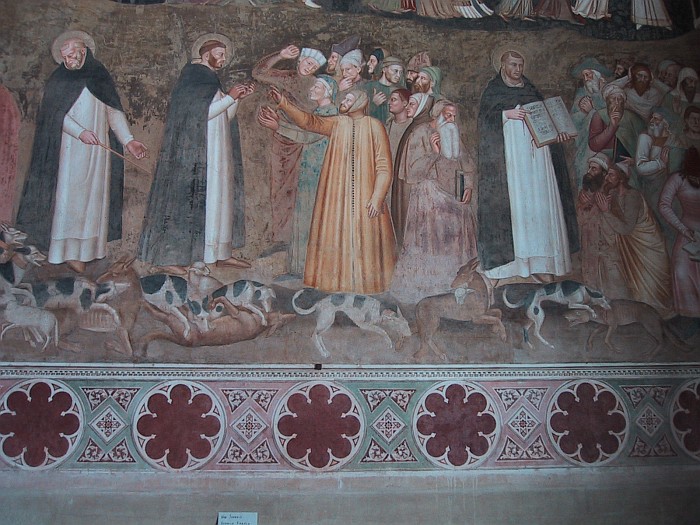
Right Wall – The Church Militant and Triumphant EW 170
A vision of Christian society; clergy and laity are united in the Corpus Christi Mysticum identified with Ecclesia, or church, shown here in the guise of Florence Cathedral. From it proceeds the road to salvation with Dominican saints Thomas Aquinas, Peter Martyr and Dominic leading the way to Paradise. In the centre of this great panorama, probably, the donor – Guidalotti – kneels at the feet of his confessor. Borsook, Florence
Vault:
· shows ship of St Peter, a symbol of the church
· to the left: a man fishing with a line (“I will make you
fishers of men.”)
· to the right: Peter invited to walk on water (Do not fear
difficulties that will face the church throughout the centuries.)
· bands of the vault: Prophets holding scrolls on which are
written the words with which they announced the birth and life of the Church
of Christ.
Wall Proper
Scene 1 (lower left)
· in background is Andrea di Bonaiuto’s model for the cupola
of the Duomo
· in front the Church Militant is represented, with all the
orders and dignitaries, beginning with the Pope (Benedict XI, the Dominican
Niccolò Boccasini). To his left are
· Emperor Charles IV, with sword and globe,
· King of France, Charles V the Wise
· an unidentified dignitary
· to his right are Cardinal Niccolò Albertini di Prato,
Dominican of Santa Maria Novella, and
· a bishop, perhaps Filippo dell’Antella, Bishop of Florence
at the time of the exile of the Duke of Athens; it could also be fra Aldobrandino
Cavalcanti, bishop of Orvieto, who is by some considered the founder of
the actual Church of Santa Maria Novella.
Below, on the left, is a group of representatives of the religious orders, mendicant and monastic, and of the order of knighthood.
Below, on the right, in a row in front of the King of France, the group of faithful includes:
Cimabue, dressed in red
Giotto, with the green hood
an English knight with the insignia of the Order of the Garter
Lapo, the architect and his son, Arnolfo
Boccaccio holding the book
Petrarch, above him, in a canonical habit (ermine cape and hood)
Dante, the figure with the green cape and white hood next to Petrarch
Kneeling in front is a group of four pilgrims: on the hat of one are the symbols of the three most popular pilgrimage sites of the Middle Ages – Veronica’s veil (Rome), the sea shell (St James of Compestola), and the palm (Palestine or the Holy Land).
It is believed that the four women who follow represent: Dante’s Beatrice, Boccaccio’s Fiametta (there is a flame on her chest under her throat), Petrarch’s Laura, and the Blessed Villana delle Botti (with the black and white veil that almost falls over her eyes).
Others believe that the figures are symbols of the four conditions of women: young girl, fiancé, bride, widow. Over the women with the black and white veil is a man dressed in armour believed to be Count Guido Novello, a Florentine captain. On the base of the Pope’s throne are five lambs resting peacefully, guarded by two black and white dogs.
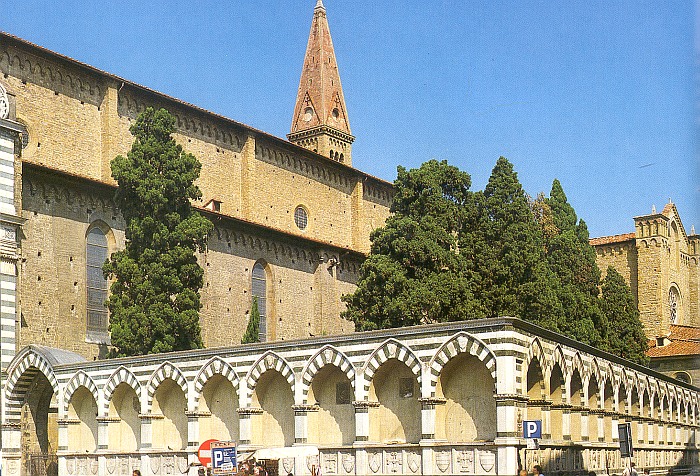
Scene 2 (bottom, right hand side)
The apostolate of the Church, particularly the preaching of the Domincans in defense of the orthodoxy undermined by the heretics and for the diffusion of the Christian doctrine among the infidels.
St Dominic (star on his head) sends his set of hounds as if on a hunt against wolves and foxes (heretics) to save lambs of God.
St Peter Martyr disputing with the heretics
St Thomas presents the heretics with the book of knowledge, containing the Scripture: “Veritatem meditabitur guttur meum et labia mea detestabuntur impium” (“For my mouth shall speak truth; and wickedness is an abomination to my lips.” Proverbs VIII, 7), the beginning text of a work by St Thomas entitled Summa contra gentes.
Scene 3 (above second)
It is also necessary to convert the bad Catholics who allow themselves to be corrupted by three capital vices and by pleasure in general (the four seated figures).
Avarice (pensive, in a green mantel)
Lust (dressed in red with a monkey on her knees)
Pride (haughty man dressed in white, with a falcon in his left hand)
Pleasure (girl playing the vielle)
This row of symbolic figures is commented upon by two series of realistic scenes placed above and below: those who look for pleasure in dances and other forms of entertainment, and those who look for it by picking the forbidden fruit in a dense forest.
Scene 4
The sacrament of penance (or confession) is offered to these sinners as a form of salvation. This scene shows a Dominican friar, sitting in a Gothic style confessional, raising his hand in benediction over a penitent sinner, and sending him absolved towards a large door of which St Peter is holding the key. A procession of purified souls receives a garland from two angels and joyfully enters Paradise.
Scene 5
Following is the fifth and last scene with a large group of blessed souls. They are all looming upward toward the terminal point of the entire composition, where, on a throne consisting of an arch of the Zodiac, in a large halo sits the Supreme Judge Jesus, with two keys (power on earth and in heaven) and the world in his hands. On the base of the throne is the immaculate Lamb; at the sides are the symbols of the four Evangelists. At the right and left of Christ are choirs of angels which fill the entire space. On the left, dominates the figure of Mary, queen of the angels and those whose work on earth continues.
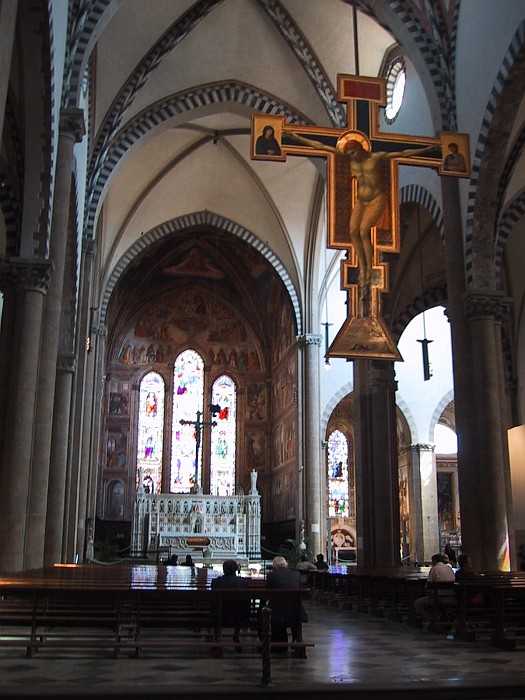
Left Wall: Triumph of Catholic Doctrine EW 170
St. Thomas Aquinas via divine revelation unifies all knowledge shown here through biblical and historical representatives.
The development of the general theme continues: Christ, Savior of Humanity bestows his grace and doctrine. After the Ascension, this work of Christ began with the Descent of the Holy Spirit on the Apostles and continues through the teaching of the Doctors of the Church, particularly with St Thomas of Aquinas.
The narration begins from the height of the vault. At the top of the triangle flies a white dove. It is the Holy Spirit descending into the room where the Apostles are in prayer around the Virgin Mary. The flame of the Spirit has already alighted on each of their heads. Notice that the Virgin is at the center of the apostolic community, while the highest authoritative figure is St Peter. Below, in front of the house, the Jews crowd around eager to know what is happening inside, having been attracted by the thunderlike noise. However, some historians believe that the persons in front of the house represent the various peoples that, through the centuries, have come into contact with the Church (the man knocking at the door might represent the Tartars, who had been reached by the Catholic missionaries right in the years when Andrea di Buonaiuto painted this chapel). In the Gothic style small windows at the sides, the five figures present the story of the Pentecost, taken from the Acts of the Apostles.
From the height of the wall, in the frieze, Jesus, with his hands open, presents the scene below: The triumph of his doctrine, personified in St Thomas Aquinas.
The Saint, wrapped in his black Dominican cape, is seated on a rich Gothic throne holding, against his chest, the book of knowledge in which is written: “Optavi et datus] e[st] m[ihi] sensus et i[n] vocavi et venit I[n] me Sp[iritu]s Sapi[entia]e et p[rae] posui illa[m] regnis et sedibus” (“I prayed and was granted prudence; I implored and the spirit of knowledge came unto me; I preferred it to kingdoms and thrones”.)
They are the scriptural words with which the first reading of the Mass begins on the feast of St Thomas. In a roundel on the cusp of the throne is the half figure of a young man with a halo who is holding an open book in his right hand and a mirror in his left (symbols of science and knowledge). Below, in two smaller roundels, are an old man (experience), and a young man (juvenile ardor of he who studies with passion). At the foot of the Saint are three personages, conquered and subjugated by his knowledge. On the left is Nestor contemplating a small temple (in fact, he taught that Christ took on human nature, living in it as in a temple, therefore denying the hypostatic union of the divine and human natures in Christ). On the right is Arius, who in the IV century denied that the Son was consubstantial with the Father. In the center is Averroës, who denied the immortality of the human soul.
At the sides and over the throne are the winged figures of the theological and cardinal virtues, that St Thomas practiced heroically and illustrated superbly in his writings. Therefore, it is fitting that they serve as a crown for him. On high, on the throne, is Charity, dressed in red with a flame on her head and two small flames in her hands (ardent in thought and action). Charity is the queen and soul of all the virtues and she alone will remain in Paradise. Farther below, on the left, is Faith, dressed in white and with the cross and shield in her hands (insignia of spiritual combat against doubt and error). On the right, Hope is dressed in a green tunic and holding a flower, symbol of the future harvest and eternal prize. Following below are the cardinal virtues. At the left of the throne: Temperance, with a small vegetable plant in her right hand, while with her left holding, on a leash, a fish that is under her feet (fish and vegetables are Lenten foods), and Prudence, with a closed book in her right hand and an open one in the left, which is turned toward the Saint. At the right of the throne: Justice, with a sword and a crown, and Fortitude, with a tower and a sword.
At the sides of the lower part of the throne are seated ten personages, five per side, of the Old and New Testaments. From left to right: Job with the book; David, King and psalmist with the lyre; St Paul the Apostle, with the sword; the four Evangelists (St Mark, St John, St Matthew, and St Luke); Moses, with the tables of the Law; Isaiah, with the book of his prophesies; Solomon (the only one without a halo) with the book of proverbs. They tell us that St. Thomas Aquinas gave the utmost importance to the study of the Sacred Scripture. But he also gave importance to the study of the various sciences, as we are shown in the allegory below.
In the lower part are fourteen large Gothic style stalls (clearly divided in the center to form two distinct series), similar to those of a solemn monastic choir. But instead of majestic and severe monks, Andrea di Bonaiuto, following the suggestions of the theologian Fra Zanobi de’ Guasconi, painted fourteen beautiful female figures.
Developing the general concept, the theologian and the artist express this thought with the splendid allegory: all the sciences, besides having their own objectives, concur in the intellectual perfection of man so that he may tend toward the ultimate end, which is God.
Since the major part of the inscriptions that were in their respective places have perished, the exact interpretation of some parts is difficult. We will give what we feel to be the best interpretation.
The allegory is narrated on three lines.
Upper line – The symbolic figures are placed in the roundels in the triangles of the cusps of each stall. Under the seven figures on the right are seven small quadrilaterals where we can still see the original initials of the names of the heavens, according to the Medieval concept. In the small hexagons, under the seven figures on the left, must have been the initials of the names of the gifts of the Holy Spirit.
Middle line – Are fourteen female figures seated in the stalls: seven on the left and seven on the right.
Bottom line – At the feet of the allegorical figures sit fourteen historical personages: eminent scholars of the sciences or arts represented above. Below are two bands of friezes with 14 + 14 large hexagonal blocks in which were the inscriptions (some traces remain) referring to the figures in the middle and bottom lines.
We therefore pass from symbolism to allegory to history.
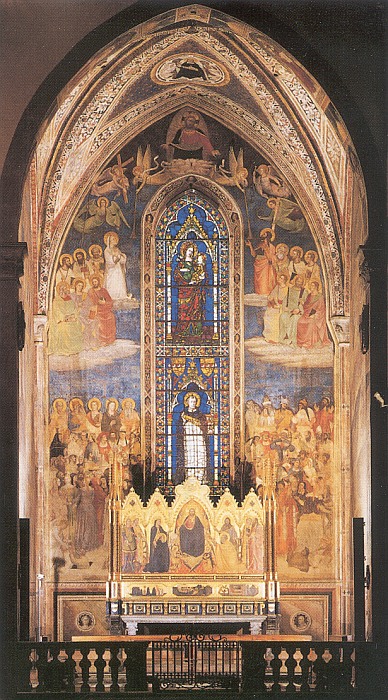
Orcagna, Cappella Strozzi
Symbolic numbers – There are seven figures on the right and seven on the left. The number 7 is formed by 4, representing matter (at that time divided into four fundamental elements: water, earth, air and fire), and by 3, representing perfection and the spirit… The stall, above the head of each figure, has an arch adorned with seven small arches. The seven small quadrilaterals, under the roundels on the left side, signify that a virtuous man is square, as Aristotle states in his Rhetoric, since the square – formed by four right angles – is the symbol of rectitude. Instead the hexagon, which has all equal sides, is the symbol, together with the equilateral triangle, of perfection (Bargellini).
The seven allegorical figures on the right refer to the activity of human intelligence whose object is temporal realities, while the seven on the left refer to the activity of human intelligence having eternal realities as an object. In the former, the Liberal Arts are signified that man acquires with the natural force of his intelligence and that, according to a Medieval concept, were under the influence of the seven planets, also called “heavens”, that were known at that time. “Each mobile heaven revolves around its center… and thus each science moves around its subject… To the first seven (heavens) correspond the seven sciences of the Trivium and Quadrivium” (Dante, Convivio, treatise II, chapter XIII). Instead, in the latter, the sacred sciences are intended, whose source is divine revelation and are under the influence of the gifts of the Holy Spirit (the corresponding Gospel Beatitudes referred to and according to the Augustinian doctrine as revised by St Thomas Aquinas).
Reading of the figures – The Liberal Arts are read from right to left, while the sacred sciences from left to right (at the center the stalls) are clearly separated. One passes from the less noble arts and sciences to the more noble. N.B. – the first five sacred sciences are the disciplines in the theological courses of the second half of the XIV century and first half of the XV century. The last two are the fruits which the Dominican must strive to obtain from study and from prayer.

ENTRANCE WALL
On it Andrea di Bonaiuto had frescoed the fourth part of the pictorial cycle of the chapel, that is, the preaching vocation, courageous to the point of martyrdom, personified in the Dominican friar St Peter Martyr of Verona. Unfortunately, only a few fragmented scenes of the Saint’s life remain. On this wall, after the chapter house became the chapel of the Spanish colony in Florence, a large tribune was built in correspondence with an upper loggia erected on the entire northern side of the Green Cloister. Thus a great part of the frescoes were destroyed.
St Peter Martyr, born in Verona at the beginning of the XIII century, was ordained in Bologna in 1221 (c.) by St Dominic himself. A great orator, he preached in Florence in 1244-1245. In order to allow the people to hear him, the town enlarged the old square of Santa Maria Novella. The Saint’s work in Florence was prodigious and he founded the Society of Faith and the first Society or Company of the Laud of Blessed Virgin, from which originated the Society of St. Maria del Bigallo and that of the Laudesi di Santa Maria Novella. He was murdered by a hired assassin of the Catharist heretics on April 6, 1252, in a forest between Rome and Milan. He was canonized by Innocent IV on March 9th of the following year.
On high is the young Saint receiving his religious habit from St. Dominic. At the right of the large window is the Saint preaching. Below on the left is the Saint’s martyrdom. On the right, the scenes refer to miracles performed by St Peter after his death.
The Trinity, Masaccio
There are various opinions as to when the fresco of The Trinity in the church of Santa Maria Novella was painted. It is mentioned in the earliest sources, and was dexcribed in detail in the 1568 second edition of the Lives by Vasari, who emphasized the virtuosity of the trompe l'oeil in the architectural structure of of the painting: a barrel vault drawn in perspective, and divided into squares with rosettes which diminish and are foreshortened so well, that there seems to be a hole in the wall. Only two years after Vasari's book was published, the erection of a stone altar caused the fresco to be covered up by a panel of the Madonna of the Rosary painted by Vasari himself. Thus the fresco remained unknown to future generations from 1570 to 1861 when owing to the removal of the 16th-century altar it was again uncovered.
A close-up view of the skeleton in the sarcophagus was also revealed the ancient warning, in clear letters: I was what you are and what I am you shall be.
